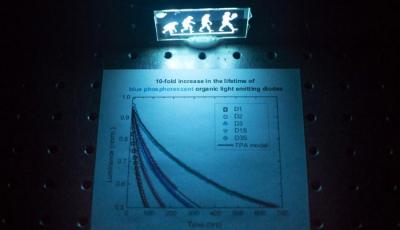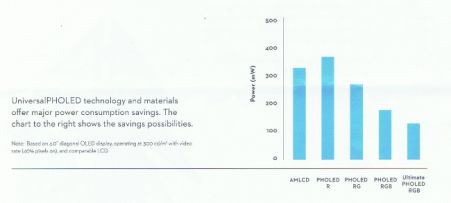Researchers from the University of Michigan developed a new phosphorescent OLED (PHOLED) emitter that extends the lifetime by a factor of 10. Researchers have been trying to develop an efficient, long-lasting blue PHOLED emitter for years now, and this may be the breakthrough everybody's been waiting for.

OLED makers SDC and LGD already use red and green PHOLED emitter materials in their OLED panels. While phosphorescent emitters do not last as long as fluorescent emitters, they are much more efficient. All commercial OLED displays currently use a fluorescent blue emitter as the best PHOLED blue to date only lasted for a few hundred hours.
The researchers, collaborating with Universal Display scientists already explained in 2008 why blue PHOLEDs do not last very long. They said that the high energies required to produce blue light are more damaging when the brightness is increased to levels needed for display or lighting panels. A concentration of energy on one molecule can combine with that on a neighbor, and the total energy is enough to break up one of the molecules.
The first idea was to spread the light-producing energy, so that molecules aren't as likely to experience the bad synergy that destroys them. To achieve this, the team arranged the molecules so that they were concentrated near the hole-conducting layer and sparser toward the electron conductor. This drew electrons further into the material, spreading out the energy.
This technique extended the lifetime of the blue PHOLED by three times. The team further discovered that splitting their design into two layers (and halving the concentration of light-emitting molecules in each layer) extended the lifetime tenfold.

A commercial blue PHOLED is very exciting for the OLED industry. Universal Display estimates that adding a blue PHOLED to an AMOLED display will reduce the power consumption by about 30% (see chart above). It will probably take years before this technology is commercialized and adopted in OLED panels on the market, but this is the first time we hear of a promising blue PHOLED approach.
Several research groups and companies are trying to develop more efficient fluorescent emitters, trying to achieve PHOLED-like efficiency without the heavy metals. Professor Chihaya Adachi at Kyushu University is developing TADF (Thermally Activated Delayed Fluorescence) emitters that seem promising.
TADF based OLEDs are also being commercialized by Cynora (based on copper). Researchers from the Universities of Bonn, Regensburg, Utah and the MIT also developed a new method to enable phosphorescence OLEDs without any heavy atoms at room temperature.
Source: EurekAlert
Disclosure: the author of this post holds shares in Universal Display
Comments
Nice paper. You can see it here...
http://www.nature.com/ncomms/2014/140925/ncomms6008/full/ncomms6008.html
Unfortunately, there is still a long long way to go for phosphorescent blue. If you look at the chart, LT95 has been improved from about 1 hour to about 10 hours (this is at 3000 cd/m2). This is still about 2 orders of magnitude too short. There is also the matter of poor color saturation. These are sky blue emitters, which can possibly be used in OLED lighting, but are not deep enough blue for OLED displays. Sadly, the deeper phosphorescent blues as needed for displays, have even shorter lifetime.
It's a nice paper (and conference presentation), but as mentioned the emitter used is from UDC's archive (I think it's been knocking around for 5-6 years.) It's a good way of demonstrating how to get better lifetime from device design, but UDC probably have already applied various LT-extending tricks to their devices years ago. For this emitter class I think I've seen UDC patent data showing 3000 h T50 which is better than this paper but still a long way short of what is required.
But this technique can probably be applied to any new blue PHOLED emitter. So we can expect UDC to use it with their latest blue emitters (maybe it also applies to green/red emitters too) and achieve even better results.
How efficient are These Blue PHOLEDs as Single Unit devices?
I always thought, that there is a Problem also with efficiency for Blue PHOLEDs.
A blue PHOLED will consume about 25% of the power of a comparable blue fluorescent emitter.


Do you have any insight on whether this innovation will be sufficient to commercialize phosp. blue to the degree we have seen green emerge, or is this a big step but not yet enough? I don't see any public events for UDC currently, they will report earnings early in November. Coot